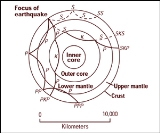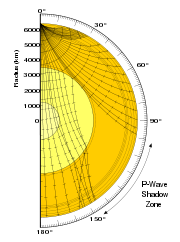
Shadow zone
Encyclopedia

Earth
Earth is the third planet from the Sun, and the densest and fifth-largest of the eight planets in the Solar System. It is also the largest of the Solar System's four terrestrial planets...
's surface where seismographs cannot detect an earthquake
Earthquake
An earthquake is the result of a sudden release of energy in the Earth's crust that creates seismic waves. The seismicity, seismism or seismic activity of an area refers to the frequency, type and size of earthquakes experienced over a period of time...
after its seismic waves have passed through the Earth. When an earthquake occurs, seismic waves radiate out spherically from the earthquake's focus. The primary seismic waves
P-wave
P-waves are a type of elastic wave, also called seismic waves, that can travel through gases , solids and liquids, including the Earth. P-waves are produced by earthquakes and recorded by seismographs...
are refracted
Refraction
Refraction is the change in direction of a wave due to a change in its speed. It is essentially a surface phenomenon . The phenomenon is mainly in governance to the law of conservation of energy. The proper explanation would be that due to change of medium, the phase velocity of the wave is changed...
by the liquid outer core of the Earth and are not detected between 104° and 140° (between approximately 11570 and 15570 km (7,189.3 and 9,674.8 mi)) from the epicenter
Epicenter
The epicenter or epicentre is the point on the Earth's surface that is directly above the hypocenter or focus, the point where an earthquake or underground explosion originates...
. The secondary seismic waves
S-wave
A type of seismic wave, the S-wave, secondary wave, or shear wave is one of the two main types of elastic body waves, so named because they move through the body of an object, unlike surface waves....
cannot pass through the liquid outer core and are not detected more than 104° (approximately 11570 kilometres (7,189.3 mi)) from the epicenter
Epicenter
The epicenter or epicentre is the point on the Earth's surface that is directly above the hypocenter or focus, the point where an earthquake or underground explosion originates...
.
The reason for this is that the velocity for P-waves and S-waves is governed by both the different properties in the material which they travel through and the different mathematical relationships they share in each case. The three properties are: incompressibility (
 ), density
), densityDensity
The mass density or density of a material is defined as its mass per unit volume. The symbol most often used for density is ρ . In some cases , density is also defined as its weight per unit volume; although, this quantity is more properly called specific weight...
(
 ) and rigidity
) and rigidityStiffness
Stiffness is the resistance of an elastic body to deformation by an applied force along a given degree of freedom when a set of loading points and boundary conditions are prescribed on the elastic body.-Calculations:...
(
 ). P-wave velocity is equal to
). P-wave velocity is equal to  where as S-wave velocity is equal to
where as S-wave velocity is equal to  and so S-wave velocity is entirely dependent on the rigidity of the material it travels through. Liquids, however, have zero rigidity, hence always making the S-wave velocity overall zero and as such S-waves lose all velocity when travelling through a liquid. P-waves, however, are only partially dependent on rigidity and as such still maintain some velocity (if greatly reduced) when travelling through a liquid. Analysis of the seismology of various recorded earthquakes and their shadow zones, led geologist
and so S-wave velocity is entirely dependent on the rigidity of the material it travels through. Liquids, however, have zero rigidity, hence always making the S-wave velocity overall zero and as such S-waves lose all velocity when travelling through a liquid. P-waves, however, are only partially dependent on rigidity and as such still maintain some velocity (if greatly reduced) when travelling through a liquid. Analysis of the seismology of various recorded earthquakes and their shadow zones, led geologistGeologist
A geologist is a scientist who studies the solid and liquid matter that constitutes the Earth as well as the processes and history that has shaped it. Geologists usually engage in studying geology. Geologists, studying more of an applied science than a theoretical one, must approach Geology using...
Richard Oldham
Richard Dixon Oldham
Richard Dixon Oldham FRS was a British geologist who made the first clear identification of the separate arrivals of P-waves, S-waves and surface waves on seismograms and the first clear evidence that the Earth has a central core.-Life:Born on 31 July 1858 to Thomas Oldham, a Fellow of the Royal...
to deduce in 1906 the liquid nature of the Earth's outer core.

